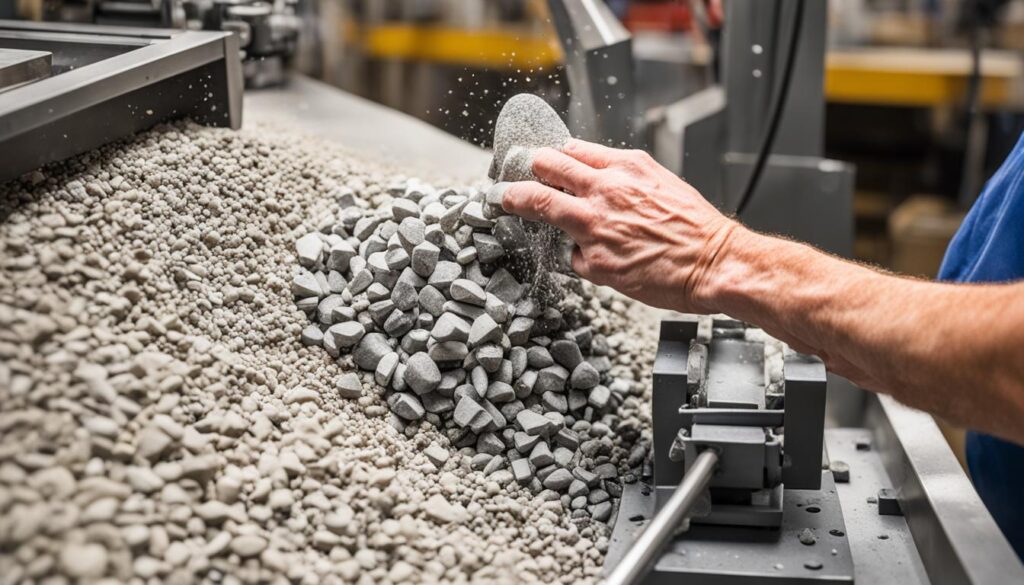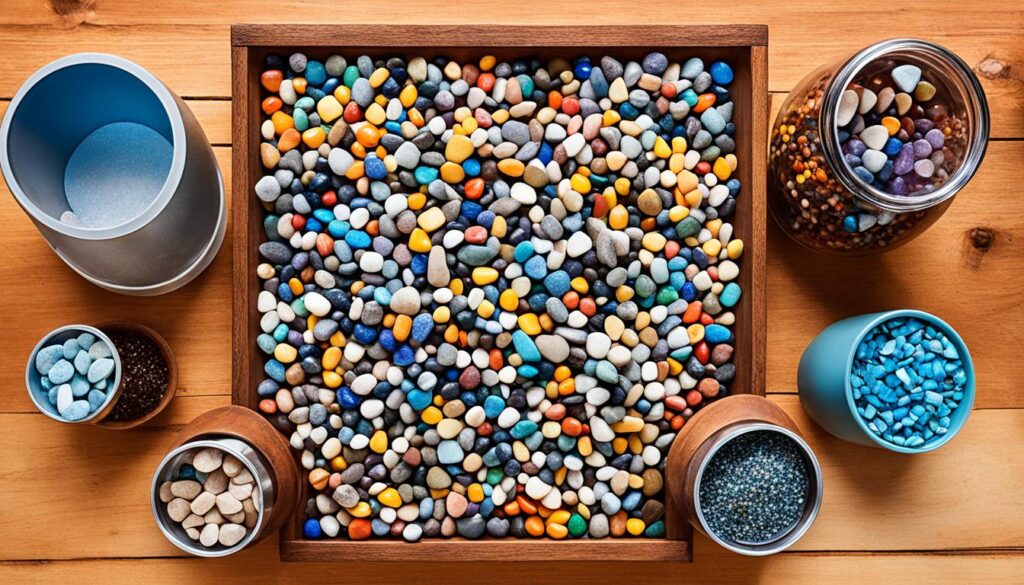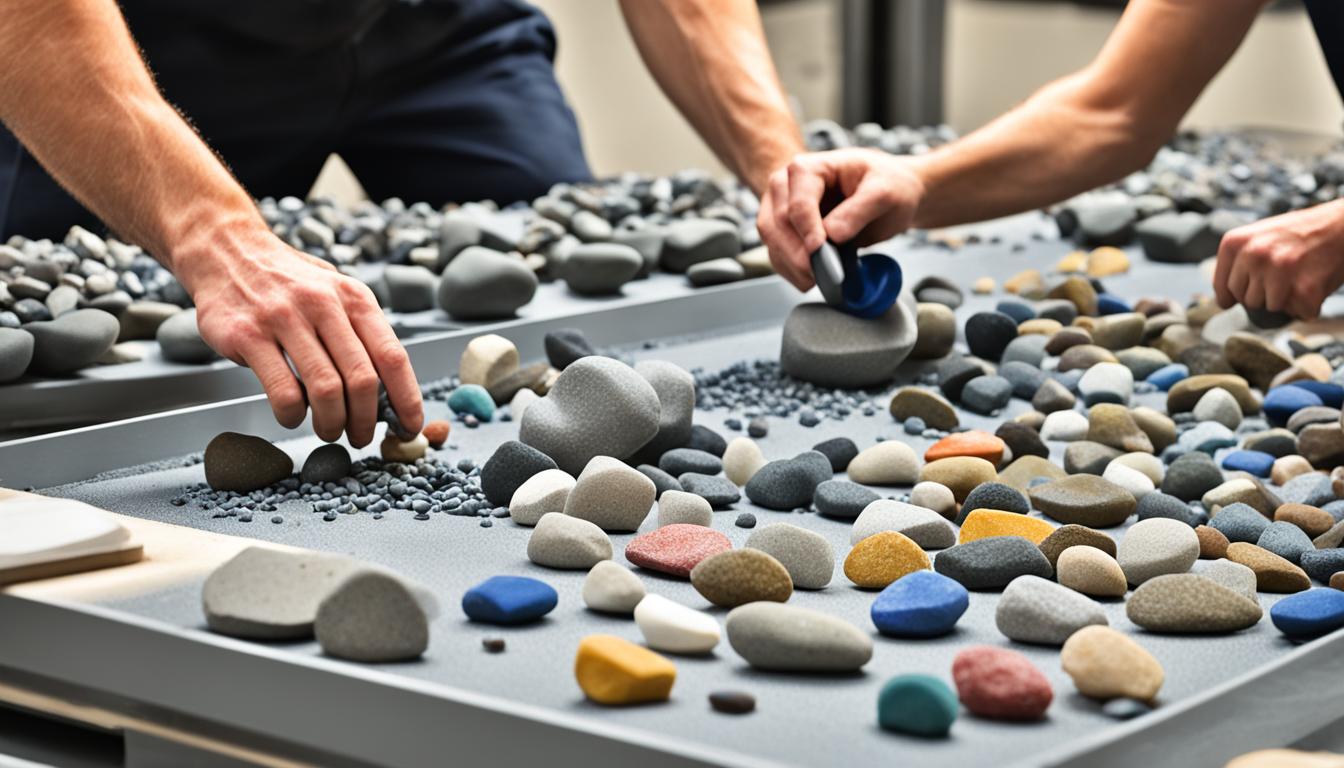This post contains affiliate links.
Ever glanced at the raw, rugged stones under your feet and wondered if they could be something more—something dazzling? Rock tumbling for beginners is a craft that turns this curiosity into reality. It’s a journey that starts with the most humble pebbles and, through rock polishing techniques, ends with a radiant collection you’ll cherish. This Beginners Rock Tumbling Guide will reveal how to polish rocks using methods that convert the ordinary into the extraordinary. Whether you’re looking to adorn your home with natural art or engage in a hands-on earth science experience, rock tumbling could be your perfect new hobby.
Key Takeaways
- Discover how simple stones can undergo a dramatic makeover into shiny gems.
- Learn the basic equipment needed for rock tumbling and the ideal starter set.
- Understand the step-by-step process of rock tumbling, from coarse grit to final polish.
- Gain insights into choosing the right types of rocks perfect for tumbling success.
- Realize the importance of patience and precision in crafting beautiful polished stones.
- Explore how you can get started on this rewarding hobby with our comprehensive guide.
Discover the Exciting World of Rock Tumbling
Welcome to the mesmerizing art of rock tumbling! Imagine taking a seemingly ordinary rock and turning it into a beautifully polished gemstone. That’s what rock tumbling offers to hobbyists and crafters alike—a chance to transform the common into the extraordinary. Perfect for those just Starting Rock Tumbling, this process is both an art and a science, making it a fulfilling pursuit for individuals of all ages.
What is Rock Tumbling?
Rock tumbling is a hobby of patience and precision. You begin with rough rocks, and through a step-by-step process involving progressively finer grits, transform them into polished stones. Each stage in this journey reflects a part of nature’s own way with the added benefit of speed. With the right Rock Tumbling Tips and Tricks, even a newcomer can attain results to take pride in.
The Origins of Rock Polishing
The history of rock tumbling tracks back to the 1950s, marking the creation of the first rock tumblers. These pioneers in the crafting world made it possible to simulate, within weeks, what would take nature centuries to accomplish. Through the use of tumblers, early enthusiasts were able to replicate the natural wearing down of stones by rivers and streams—polishing and smoothing rough edges to reveal the hidden beauty beneath.
Ready to get started? Your journey will lead you through the selection of the perfect stones to the final breathtaking result. Embrace the step-by-step process, and you’ll find yourself captivated by the transformation, cementing Rock Tumbling as your next engaging hobby.
The Essential Rock Tumbling Equipment
When embarking on your beginner-friendly rock tumbling journey, it all starts with the cornerstone piece of equipment: the rock tumbler itself. This pivotal gear is what transforms rough stones into polished marvels. It’s essential to not just select any tumbler, but to arm yourself with the best rock polishers in 2024 that ensure ease of use, reliability, and satisfaction in your polishing endeavors.
Choosing the Right Rock Tumbler
Apt for novices, a great rock tumbler guide would advocate for a machine that combines user-friendliness with robust construction. The market has a range of tumblers, but brands like Lortone and Thumler’s have proven to be reliable choices. They offer models that are perfect for the volume of rocks you’re considering for your first tumbling venture. The key is to find a tumbler with a barrel size that matches your intended batch and one that promises consistent rotation for even polishing.
Necessary Supplies and Grits
Aside from the rock tumbler itself, your success in rock tumbling will also depend on the quality of supplies you use. This includes a variety of grits for the different stages of tumbling and additional accessories that aid the process. Here’s a breakdown of the necessary supplies for effective beginner-friendly rock tumbling:
| Supply Type | Description | Function |
|---|---|---|
| Rough Rocks | Stones selected for tumbling | Starting material that will be polished into gems |
| Coarse Grit | Silicon carbide or similar abrasive | Facilitates the initial shaping and smoothing of rough edges |
| Medium Grit | Fine abrasives for further smoothing | Further refines rock surfaces after initial grind |
| Fine Grit/Pre-Polish | Ultra-fine abrasive for pre-polishing | Prepares rocks for final polish, ensuring a smoother finish |
| Polishing Compound | Final-stage polish like aluminum oxide | Gives rocks the desired shine and luster |
| Ceramic Media | Small non-abrasive ceramic shapes | Improves tumbling action and aids in the polishing process |
| Mesh Bag | Cloth or plastic bag for grit disposal | Separates grit from slurry for cleaner disposal |
As you amass your supplies, ensure that you have a progression of grits from coarse to fine, which are critical for the step-by-step refinement of your rocks. Each level of coarseness smoothens the rocks more, ultimately leading to a polished treasure you can be proud of.
With the appropriate tools and equipment, your beginner-friendly rock tumbling experience will not only be enjoyable but a fruitful introduction to an enriching hobby that could last a lifetime.
Rock Tumbling 101: Beginner’s Guide to Polishing Rocks
Embarking on the journey of rock tumbling for beginners is like discovering a hidden crafting niche where patience and meticulous attention to detail are the keys to creating captivating, polished gems from the ordinary stones you might find anywhere. As you delve into rock tumbling techniques, you’ll find that mastering this craft involves a step-by-step rock tumbling process with several distinct stages. Let’s explore these stages to help you transform rough stones into glistening treasures.
Starting out in this hobby, you’ll soon realize that each stage of rock tumbling is a crucial part of the metamorphosis from a jagged pebble to a polished artifact. Here’s a simple, step-by-step rock tumbling guide personalized for beginners:
- Cleaning Your Stones: Before the tumbling begins, meticulously clean your rocks. This removes loose particles that might interfere with the process.
- Sorting Your Stones: Organize your stones by hardness and size, as this will ensure a uniform finish and prevent the harder stones from damaging softer ones during the tumbling process.
- The Coarse Grind: Begin with a coarse grit to knock off the sharp edges and get your rocks ready for further refinement.
- Intermediate Stages: As you progress, you’ll switch to finer grits. These stages gradually smooth out the crevices and prepare the rock surface for a high polish.
- Polishing: In the final stage, use a polishing compound to achieve that gleaming surface on your rocks.
Your endurance through this process will pay off as you see the transformation before your eyes. Remember, just as each stone is unique, so too will be your experience with rock tumbling. As you gain experience and confidence, you may even develop your own preferred rock tumbling techniques. But for now, embrace the beginner’s path, and you’ll enjoy watching those hidden gems emerge.
Identifying Rocks Suitable for Tumbling
Embarking on your rock tumbling journey, it’s imperative to start on the right foot by selecting the appropriate stones. To ensure the best results with your Beginners Rock Tumbling Guide, let’s delve into the criteria for choosing your rocks wisely.
The Mohs Hardness Scale Explained
When you are learning How to Polish Rocks, familiarity with the Mohs Hardness Scale becomes your ally. This scale, ranging from 1 (talc) to 10 (diamond), helps you appraise the hardness of your potential gems. Rocks with a hardness between 5 and 7 are ideal, providing a balance that is not too prone to cracking nor too resistant to the abrasion needed for polishing.
Types of Rocks Perfect for Beginners
As you explore various types of rocks, you’ll discover some are more suited to tumbling than others. Stones like agate and jasper not only fall within the optimal hardness range but are also nonporous. They have the kind of smooth starting surface that lends itself to a satisfying shine, which is a pivotal component of Rock Tumbling Tips and Tricks.
| Rock Type | Mohs Hardness | Ideal for Tumbling? | Additional Notes |
|---|---|---|---|
| Agate | 6.5 – 7 | Yes | Comes in a variety of colors; excellent for tumbling |
| Jasper | 6.5 – 7 | Yes | Opaque with unique patterns; polishes well |
| Quartz | 7 | Yes | Widely available; clear varieties might show every imperfection |
| Amethyst | 7 | Yes | Quartz variety; purple color adds interest to finished pieces |
| Marble | 3 – 5 | No | Too soft; risks being ground down too quickly |
Remember, the right rock selection not only contributes to the success of your tumbling but enhances your enjoyment of this rewarding hobby, a cornerstone of the Beginners Rock Tumbling Guide.
Preparing Your Rocks for the Tumbler
When starting rock tumbling, the preliminary step is to ensure your stones are optimally prepped for the journey they’re about to endure. Proper preparation is the cornerstone of how to polish rocks effectively using rock polishing techniques. Let’s meticulously plan your approach to this exciting activity.
- Determine the hardness of your rocks to group similar types together. This ensures consistent polishing and prevents harder stones from damaging softer ones.
- Inspect each specimen, looking carefully to exclude any rocks with pores or hidden cracks, which may interfere with the grit and affect the polishing process.
- Size your rocks appropriately, aiming for pieces that are uniform in order to achieve a smooth and even finish.
Here’s a detailed guide on how to size and sort your rocks:
| Rock Hardness | Inspection Tips | Sizing Advice |
|---|---|---|
| 5 to 7 on the Mohs scale | Check for cracks by holding up to light | Keep sizes within a half-inch variance |
| Avoid very soft or brittle rocks | Gently tap to ensure solidity | Large pieces may need breaking down |
| Group by hardness level | Smooth out major protrusions | Avoid overly small pieces to prevent loss |
Remember, patience and attention to detail before tumbling can significantly impact the quality of your polished stones. Dedicate time to this stage to make your rock polishing techniques more effective, and prepare to be amazed by the transformation of your rocks!
Step-by-Step Rock Tumbling Process
Welcome to the transformative world of rock tumbling! Ready to take your rough, unpolished stones and turn them into gleaming gems? Follow these beginner-friendly rock tumbling techniques that will guide you through each phase of the process.

The Coarse Grind Phase
The journey from jagged rock to polished stone begins with the coarse grind. Here, you’ll add a generous sprinkle of coarse grit to your tumbler, which will scour the surface of your stones, smoothing out those sharp edges and laying the foundation for the subsequent steps in the rock tumbling process. Patience is key; let the tumbler work its magic over several days for best results.
Medium and Fine Grinds: Refining Your Gems
After the initial abrasive dance, step down to a medium grit. This is where you’ll begin to see your stones shaping up. The edges get smoother, and the surfaces start to reveal the potential hidden underneath. Advance to a fine grit and observe an even more refined finish, setting the stage for the ultimate shine these future gems are about to receive.
The Final Polishing: Achieving the Perfect Shine
With the roughness handled, now comes the crowning moment—the final polish. This step calls for the finest polish grit, which will coax the stones into revealing their true luster. It’s a mesmerizing transformation that will leave you with iridescent gems as a reward for your dedication through this step-by-step rock tumbling journey.
| Phase | Grit Type | Grit Size | Duration (days) |
|---|---|---|---|
| 1 – Coarse Grind | Silicon Carbide | 60-90 | 7-10 |
| 2 – Medium Grind | Silicon Carbide | 120-220 | 7 |
| 3 – Fine Grind | Silicon Carbide | 500 | 7 |
| 4 – Final Polish | Aluminum Oxide | Ultra-Fine | 7 |
Rest assured, rock tumbling can be a meditative task, blending art with technique. By adhering to these beginner-friendly rock tumbling steps, you make the age-old natural process of stone smoothing an accessible, enjoyable craft right in your own home. Keep tumbling and watch as simple stones become treasures!
Maintenance and Cleaning Tips for Your Rock Tumbler
Embarking on your starting rock tumbling adventure comes with the joy of creating polished gems, but to keep the magic going, a beginner-friendly rock tumbling practice includes proper maintenance and cleaning. Regular care is more than a mere suggestion—it’s an essential part of ensuring your rock tumbler operates efficiently, producing high-quality polished stones every time.
Let’s walk through some rock tumbling tips and tricks to maintain your tumbler:
- After each tumbling cycle, ensure all parts are properly cleaned to remove any residual grit or rock fragments.
- Regularly inspect and clean the barrel, lid, and gaskets to prevent leaks and wear.
- Check the rollers and the base for any debris or rock dust that may cause the tumbler to operate inefficiently.
Proper storage is also crucial for the longevity of your equipment. Place your rock tumbler in a dry, cool area away from direct sunlight. Humidity and heat can damage parts of the tumbler and lead to premature wear. Now, let’s look at a detailed routine maintenance table for your rock tumbler:
| Component | Cleaning Routine | Maintenance Tips |
|---|---|---|
| Barrel | After each use, clean with warm, soapy water and rinse thoroughly. | Inspect for cracks and ensure the seal is tight. |
| Lid & Gaskets | Wipe with a damp cloth to remove any grit and check gaskets for wear. | Replace gaskets periodically to ensure a leak-proof seal. |
| Rollers | Brush off any accumulated rock powder or grit. | Lubricate bearings if necessary to ensure smooth operation. |
| Motor | Clean vent areas to ensure proper cooling. | Bring in for service if unusual noises or smells are detected during operation. |
Remember, keeping your rock tumbler in top shape is part of the rewarding experience of starting rock tumbling. By incorporating these rock tumbling tips and tricks into your routine, you’ll be able to focus on creating those vibrant polished rocks you love so much, knowing that your tumbler will be ready for its next batch when you are. Happy tumbling!
Common Challenges and Troubleshooting in Rock Tumbling
As you delve deeper into the engrossing hobby of rock tumbling, you might encounter a few roadblocks on your path to glistening gemstones. Fret not, as rock tumbling troubleshooting is part and parcel of mastering how to polish rocks. Let’s explore some of the frequently faced issues and smart solutions to keep your rock tumbling experience as smooth as the stones you’re polishing.
Addressing Noise and Leak Issues
Rock tumbling for beginners often comes with the surprise discovery that the process isn’t always quiet. The sound of rocks churning in the tumbler can be significant, especially in confined spaces. To mitigate the noise level, consider placing your tumbler on a rubber mat or mounting it inside a sound-dampening box. When operating in shared spaces, it’s courteous to find a location that reduces the disturbance to others.
Leakage from the tumbler barrel is another common hiccup. Prevent leaks by ensuring proper seals are in place and checking that the lid is securely fastened before each tumbling run. Regularly inspect the seal for wear and replace it as necessary. A well-maintained tumbler is also less likely to spring a leak, so keep up with your equipment’s care requirements and manufacturer’s instructions.
How to Prevent Grit Contamination
Grit contamination can turn your anticipated polished rocks into a cloudy disappointment. To keep each batch of rocks and their respective grit levels separate, thoroughly cleanse your tumbler and stones at the conclusion of each tumbling phase. Additionally, include only sturdy, non-flaking stones in your batches to reduce unwanted debris. A clean tumbler results in gleaming stones.
| Challenge | Troubleshooting Tip | Maintenance Advice |
|---|---|---|
| Noise during operation | Use a rubber mat or a soundproof box | Conduct regular sound-muffling measures adjustment |
| Leaks from the barrel | Check seal integrity and barrel lid tightness | Replace seals and inspect hardware periodically |
| Grit contamination | Implement rigorous cleaning between stages | Avoid introducing brittle or flaking rocks |
Remember, each challenge you overcome in rock tumbling strengthens your expertise and edges you closer to perfection. Embrace these troubleshooting tips as stepping stones to your success!

Creative Ideas for Your Polished Rocks
The journey of rock tumbling doesn’t end with achieving a polished sheen; it’s only just the beginning. Your new collection of glossy stones serves as a versatile medium for Creative Rock Tumbling pursuits. Transform these natural beauties into unique, handcrafted items or display them as a testament to your dedication and skill. The possibilities for Polished Rocks Crafts are only limited by your imagination.
Incorporating Gems into Jewelry and Crafts
Imagine turning your stones into stunning, wearable art. Whether you’re stringing together a bracelet, embedding a stone into a pendant, or adorning a set of earrings, the authentic touch of natural stone is unmatched. Each piece tells a story—not just of the stone’s geological past, but of your artistic journey in bringing its inner beauty to light.
- Necklaces with a central polished stone focus
- Keychains featuring smaller tumbled rocks
- Decorative boxes adorned with stone mosaics
- Custom wine stoppers topped with a singular polished gem
Displaying and Storing Your Finished Stones
Perhaps your passion for Rock Tumbling Designs leans towards curating a visual experience. Arrange your gemstones in a display case, or use them to fill a clear vase for a burst of natural color. Safely store and showcase your precious stones, as they embody the hours of tumbling and patient craftwork invested in each specimen.
| Display Option | Description | Visual Appeal |
|---|---|---|
| Shadow Box | A framed box with a glass front to showcase stones in a layered arrangement | Modern and chic, great for wall hanging |
| Glass Bowl | A transparent container allowing for a 360-degree view of the stones | Classic and versatile, perfect for table centers |
| Custom Shelves | Small shelves designed for individual stones, highlighting their unique qualities | Personalized and engaging, adds texture to room decor |
| Velvet-Lined Boxes | Elegant cases that protect the stones from dust and damage | Luxurious feel, ideal for collectors |
Remember, the stones you’ve spent weeks tumbling are more than just shiny objects—they’re tokens of your time and creativity. Whether you wear them, share them, or simply admire them, these polished rocks are a reflection of your artistic potential, brought forth through the medium of Creative Rock Tumbling.
Conclusion
As you stand at the threshold of this enthralling adventure, remember that rock tumbling is more than just a pastime—it’s a craft that captures the essence of patience and transformation. With the insights provided by this beginner’s guide to polishing rocks, you’re now equipped with the foundational knowledge to embark on your rock tumbling journey. As each stone rolls in the tumbler, consider it a metaphor for the continuous learning and refinement you’ll experience in this engaging hobby.
Embarking on Your Rock Tumbling Journey
Your journey will lead you to uncover the secrets of each stone, learning to discern their unique qualities and witness their metamorphosis into polished marvels. The rock polishing knowledge you gain along the way will enhance your appreciation for the intrinsic beauty of natural elements and perhaps, even awaken a profound connection with the earth’s geological wonders. So, set forth with enthusiasm, knowing that each polished stone is a milestone in your artistic quest.
Communities and Resources for Continued Learning
A novice’s path is made easier with the support of the rock tumbling community—a group of passionate individuals who value sharing experiences and expertise. Engage with online forums and tutorials, where you can soak up invaluable rock polishing knowledge, and don’t hesitate to reach out for advice or share your own successes. As you continue to build your skills, remember that the community is a wellspring of inspiration and camaraderie, ensuring that your hobby remains a source of joy and fascination.
FAQ
What Is Rock Tumbling?
What Equipment Do I Need to Start Rock Tumbling?
Which Rocks Are Best for Beginners?
What Are the Stages of Rock Tumbling?
How Long Does the Rock Tumbling Process Take?
How Do I Choose the Right Rock Tumbler?
How Can I Maintain My Rock Tumbler?
What Do I Do If My Rock Tumbler Is Very Noisy?
Can I Tumble Different Types of Rocks Together?
What Creative Projects Can I Do with Polished Rocks?
Where Can I Find a Rock Tumbling Community?
Source Links
- https://www.abcrafty.com/rock-tumbling-guide/
- https://rocktumbling.co/beginners-guide/
- https://rocktumbler.com/tips/rock-tumbler-instructions/
This post contains affiliate links.

